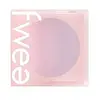What's inside
What's inside
 Key Ingredients
Key Ingredients

 Benefits
Benefits

 Concerns
Concerns

 Ingredients Side-by-side
Ingredients Side-by-side

Talc
AbrasiveMica
Cosmetic ColorantHydrogenated Poly(C6-14 Olefin)
EmollientDimethicone
EmollientCI 77891
Cosmetic ColorantDiisostearyl Malate
EmollientSynthetic Fluorphlogopite
Diphenylsiloxy Phenyl Trimethicone
Skin ConditioningDimethicone Crosspolymer
Emulsion StabilisingDimethicone/Vinyl Dimethicone Crosspolymer
Skin ConditioningEthylhexylglycerin
Skin ConditioningCI 75470
Cosmetic ColorantCI 77007
Cosmetic ColorantAluminum Myristate
Emulsion StabilisingTriethoxycaprylylsilane
Glyceryl Caprylate
EmollientCI 19140
Cosmetic ColorantCI 77499
Cosmetic ColorantTocopherol
AntioxidantTalc, Mica, Hydrogenated Poly(C6-14 Olefin), Dimethicone, CI 77891, Diisostearyl Malate, Synthetic Fluorphlogopite, Diphenylsiloxy Phenyl Trimethicone, Dimethicone Crosspolymer, Dimethicone/Vinyl Dimethicone Crosspolymer, Ethylhexylglycerin, CI 75470, CI 77007, Aluminum Myristate, Triethoxycaprylylsilane, Glyceryl Caprylate, CI 19140, CI 77499, Tocopherol
Water
Skin ConditioningMethyl Trimethicone
Skin ConditioningDimethicone
EmollientCetyl Ethylhexanoate
EmollientIsononyl Isononanoate
EmollientAlcohol Denat.
AntimicrobialPolybutene
Polypropylsilsesquioxane
Butylene Glycol
HumectantGlycerin
HumectantPEG-10 Dimethicone
Skin ConditioningPentylene Glycol
Skin ConditioningVinyl Dimethicone/Methicone Silsesquioxane Crosspolymer
1,2-Hexanediol
Skin ConditioningChlorella Vulgaris Extract
Skin ConditioningPrunus Armeniaca Fruit Extract
Skin ConditioningSodium Hyaluronate
HumectantDisteardimonium Hectorite
StabilisingMagnesium Sulfate
Bis-Diglyceryl Polyacyladipate-2
EmollientCetyl PEG/PPG-10/1 Dimethicone
EmulsifyingGlucose
HumectantFructooligosaccharides
HumectantFructose
HumectantEthylhexylglycerin
Skin ConditioningTrisodium Ethylenediamine Disuccinate
Triethoxycaprylylsilane
Panthenol
Skin ConditioningAluminum Hydroxide
EmollientPentaerythrityl Tetra-Di-T-Butyl Hydroxyhydrocinnamate
AntioxidantTocopherol
AntioxidantCI 77891
Cosmetic ColorantCI 77492
Cosmetic ColorantMica
Cosmetic ColorantCI 77491
Cosmetic ColorantCI 73360
Cosmetic ColorantCI 77007
Cosmetic ColorantIron Oxides
Water, Methyl Trimethicone, Dimethicone, Cetyl Ethylhexanoate, Isononyl Isononanoate, Alcohol Denat., Polybutene, Polypropylsilsesquioxane, Butylene Glycol, Glycerin, PEG-10 Dimethicone, Pentylene Glycol, Vinyl Dimethicone/Methicone Silsesquioxane Crosspolymer, 1,2-Hexanediol, Chlorella Vulgaris Extract, Prunus Armeniaca Fruit Extract, Sodium Hyaluronate, Disteardimonium Hectorite, Magnesium Sulfate, Bis-Diglyceryl Polyacyladipate-2, Cetyl PEG/PPG-10/1 Dimethicone, Glucose, Fructooligosaccharides, Fructose, Ethylhexylglycerin, Trisodium Ethylenediamine Disuccinate, Triethoxycaprylylsilane, Panthenol, Aluminum Hydroxide, Pentaerythrityl Tetra-Di-T-Butyl Hydroxyhydrocinnamate, Tocopherol, CI 77891, CI 77492, Mica, CI 77491, CI 73360, CI 77007, Iron Oxides
 Reviews
Reviews

Ingredients Explained
These ingredients are found in both products.
Ingredients higher up in an ingredient list are typically present in a larger amount.
This pigment is called Ultramarine blue lazurite. It gives a saturated blue color, but can be used to create other colors as well.
According to the manufacturer, it is usually made from kaolin, sodium sulfate, sodium carbonate, sulfur, and charcoal.
Ci 77891 is a white pigment from Titanium dioxide. It is naturally found in minerals such as rutile and ilmenite.
It's main function is to add a white color to cosmetics. It can also be mixed with other colors to create different shades.
Ci 77891 is commonly found in sunscreens due to its ability to block UV rays.
Learn more about CI 77891Dimethicone is a type of synthetic silicone created from natural materials such as quartz.
What it does:
Dimethicone comes in different viscosities:
Depending on the viscosity, dimethicone has different properties.
Ingredients lists don't always show which type is used, so we recommend reaching out to the brand if you have questions about the viscosity.
This ingredient is unlikely to cause irritation because it does not get absorbed into skin. However, people with silicone allergies should be careful about using this ingredient.
Note: Dimethicone may contribute to pilling. This is because it is not oil or water soluble, so pilling may occur when layered with products. When mixed with heavy oils in a formula, the outcome is also quite greasy.
Learn more about DimethiconeEthylhexylglycerin (we can't pronounce this either) is commonly used as a preservative and skin softener. It is derived from glyceryl.
You might see Ethylhexylglycerin often paired with other preservatives such as phenoxyethanol. Ethylhexylglycerin has been found to increase the effectiveness of these other preservatives.
Mica is a naturally occurring mineral used to add shimmer and color in cosmetics. It can also help improve the texture of a product or give it an opaque, white/silver color.
Serecite is the name for very fine but ragged grains of mica.
This ingredient is often coated with metal oxides like titanium dioxide. Trace amounts of heavy metals may be found in mica, but these metals are not harmful in our personal products.
Mica has been used since prehistoric times throughout the world. Ancient Egyptian, Indian, Greek, Roman, Aztec, and Chinese civilizations have used mica.
Learn more about MicaTocopherol (also known as Vitamin E) is a common antioxidant used to help protect the skin from free-radicals and strengthen the skin barrier. It's also fat soluble - this means our skin is great at absorbing it.
Vitamin E also helps keep your natural skin lipids healthy. Your lipid skin barrier naturally consists of lipids, ceramides, and fatty acids. Vitamin E offers extra protection for your skin’s lipid barrier, keeping your skin healthy and nourished.
Another benefit is a bit of UV protection. Vitamin E helps reduce the damage caused by UVB rays. (It should not replace your sunscreen). Combining it with Vitamin C can decrease sunburned cells and hyperpigmentation after UV exposure.
You might have noticed Vitamin E + C often paired together. This is because it is great at stabilizing Vitamin C. Using the two together helps increase the effectiveness of both ingredients.
There are often claims that Vitamin E can reduce/prevent scarring, but these claims haven't been confirmed by scientific research.
Learn more about TocopherolTriethoxycaprylylsilane is a silicone used to bind and stabilize ingredients.
As an emulsifier, it helps prevent ingredients from separating. This can help elongate the shelf life of products.
Triethoxycaprylylsilane is often used to coat mineral sunscreens ingredients to help give a better feel. It also helps reduce oxidative stress in sunscreens.
Learn more about Triethoxycaprylylsilane